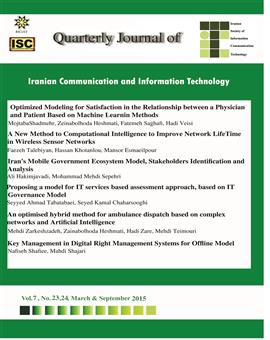ارائۀ روشی مبتنی بر هوش محاسباتی، برای بهبود مصرف انرژی در شبکه¬های هوشمند حسگر بی¬سیم
الموضوعات :فائزه طالبیان 1 , حسن ختن¬لو 2 , منصور اسماعیل¬پور 3
1 - کارمند
2 - .دانشگاه آزاد واحد همدان؛پردیس تحصیلات تکمیلی علوم
3 - .دانشگاه آزاد واحد همدان؛پردیس تحصیلات تکمیلی علوم
الکلمات المفتاحية: شبکه های هوشمندحسگر بی سیم, الگوریتم رقابت استعماری, تعادل انرژی, طول عمر شبکه,
ملخص المقالة :
پیشرفت های اخیر در زمینه الکترونیک و مخابرات بی سیم، توانایی طراحی و ساخت حسگرهایی را با توان مصرفی پایین، اندازه کوچک، قیمت مناسب و کاربری های گوناگون داده است. ظرفیت محدود انرژی حسگرها، چالش بزرگی است که این شبکه ها را تحت تاثیر قرار می دهد. خوشه بندی به عنوان یکی از روش های شناخته شده برای مدیریت این چالش استفاده می شود. برای یافتن مکان مناسب سرخوشه ها از الگوریتم رقابت استعماری که یکی از شاخه های هوش محاسباتی می باشد استفاده شده است. سرخوشه ها توسط مدل سه سطحي در ارتباط هستند، تا سرخوشه هايي با ظرفيت انرژي كم و دور از ايستگاه به عنوان سطح سوم شناخته شده و به طور غير مستقيم با ايستگاه پايه به تبادل اطلاعات بپردازد. اين موضوع باعث افزايش طول عمر شبکه های حسگر بی سیم مي شود
.W.B. Heinzelman, A.P. Chandrakasan, and H. Balakrishnan, An application-specific protocol architecture for wireless microsensor networks. Wireless Communications, IEEE Transactions on, 2002. 1(4): p. 660-670.
2.R. Min, et al. Low-power wireless sensor networks. in VLSI Design, 2001. Fourteenth International Conference on. 2001: IEEE.
3.I.F. Akyildiz, et al., A survey on sensor networks. Communications magazine, IEEE, 2002. 40(8): p. 102-114.
4.A.A. Abbasi and M. Younis, A survey on clustering algorithms for wireless sensor networks. Computer communications, 2007. 30(14): p. 2826-2841.
5.J.N. Al-Karaki and A.E. Kamal, Routing techniques in wireless sensor networks: a survey. Wireless Communications, IEEE, 2004. 11(6): p. 6-28.
6.L. Subramanian and R.H. Katz. An architecture for building self-configurable systems. in Mobile and Ad Hoc Networking and Computing, 2000. MobiHOC. 2000 First Annual Workshop on. 2000: IEEE.
7.Z. Yong and Q. Pei," A energy-efficient clustering routing algorithm based on distance and residual energy for Wireless Sensor Networks. Procedia Engineering, 2012. 29: p. 1882-1888.
8.W.R. Heinzelman, A. Chandrakasan, and H. Balakrishnan. Energy-efficient communication protocol for wireless microsensor networks. in System Sciences, 2000. Proceedings of the 33rd Annual Hawaii International Conference on. 2000: IEEE.
9.A.M. Jasour, E. Atashpaz, and C. Lucas. Vehicle fuzzy controller design using imperialist competitive algorithm. in Second First Iranian Joint Congress on Fuzzy and Intelligent Systems, Tehran, Iran. 2008.
10.E. Atashpaz-Gargari and C. Lucas. Imperialist competitive algorithm: an algorithm for optimization inspired by
imperialistic competition. in Evolutionary Computation, 2007. CEC 2007. IEEE Congress on. 2007: IEEE.
11. S. Bayraklı, and S. Z.Erdogan. Genetic Algorithm Based Energ Efficient Clusters (GABEEC) in Wireless Sensor Networks, Procedia Computer Science 10, 247-254. 2012.
12.N.Enami, R .Askari Moghadam, K.Dadashtabar, M.Hoseini. Neural Network Based Energy Efficiency in Wireless Sensor Networks: a Survey’, In: International Journal of Computer Science & Engineering Survey (IJCSES) , Vol.1, No.1, August 2010, pp.39-55.
13.L.Shahvandi ,M.Teshnehlab, and A.Haroonabadi. A Novel Clustering in Wireless Sensor Networks used by Imperialist Competitive Algorithm, 2011.


